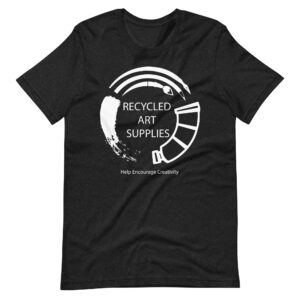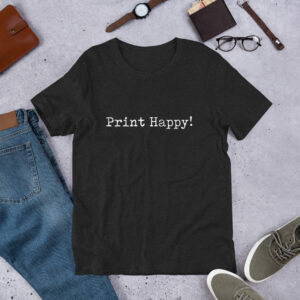
Carving a Linocut can be challenging at first. However, after some guidance and trial and error it becomes quite satisfying and a large reason why people enjoy Linocut and Woodcut so much.
One of the first things to consider is that everytime you carve a line or make a mark using your tools into linoleum your removing the color you are planning on using. The linoleum block is not inked while you carve into it. You will be drawing with the carving tools light or white.

A good example could be when you use a black scratch board if you’ve ever used one. The surface is black and you use a pencil or something like a coin to remove lines and reveal the white underneath. This essentially is what will happen when you carve into a linoleum.
However, when you get a grey or sometimes pink linoleum you do not automatically see white underneath when you carve. To aid in this visual, some artists place a wash of paint or india ink on the surface of their linoleum in order to get the finished carved look while carving.
General carving rules
Here are some rules to follow when carving. It can be dangerous if you are not careful because you are working with sharp objects.
1. Always cut away from yourself. Please when you are carving a linoleum block, make sure and be mindful of where your carving tool is positioned at all times.
You will always want to make sure when you carve you are not carving towards yourself.
2. Secure the linoleum or woodblock. There are a few ways to do this, by using a bench hook or by using a non slip surface on your table.
A bench hook helps secure the linoleum to the table when you add pressure with your carving tools. It is a really wonderful tool that I have made plans for that you can get free here.
The non slip material I use is a little bit of cabinet liner. It is a bit of textured rubber material.
I use this in place of a bench hook for workshops. It works pretty well. Here is a non affiliate link to what I am referring to.
3. Be mindful of your other (non carving) hand. I have stabbed my non carving hand a few times while working on a project because I was not paying attention to where my other hand was located. Learn from my mistakes. Please. You’ll be happier you did.
4. Try and ensure your blades on your tools are sharp. Dull tools will not carve efficiently and can cause errors on your project which can be very difficult to repair. Use a slipstrop to deburr your tools and this will help a lot.
These are just some of the beginning carving warnings that anyone should be aware of when getting started on a project.
As always, please be careful carving your linoleum or your woodcut.
Carving Lines
Lines are probably the most important element in a linocut or a woodcut. When carving a linocut or a woodcut the thing to remember is that all carved areas will be without color.
So if you are carving into a linocut block and you plan on using a solid color, all the lines carved out will be white (or whatever color your paper is).
If you are working on a reduction linocut, then whatever you carve out will be the color of the previously printed color. (I will go over this in detail in future blog posts).
Cross Hatching
Normally when you draw with cross hatching, (using a series of lines to create value), you are using lines to darken an area. However, in woodcut or linocut, you use those same lines to create lighter areas. The more lines you make the lighter the area becomes.
Clearing Out

Sometimes when I know I will be using color later, either with other blocks or with watercolor, I will just leave the outlines of the drawing on the linoleum and clear out the rest. Clearing out is when you remove any linoleum material that is not part of your drawing. Usually used in all the large spaces you do not want printed.
The clearing out can be done with a large u gouge. I go into some of the tools in a different blog post. Or you can do the clearing out by cutting away the linoleum from around your drawing. This can be useful if you want to use your linoleum blocks like stamps or if you want to use several blocks together with different inks and puzzle them together.
Designs and Patterns
If you are not going for a realistic linocut image you can create some really cool images with patterns and designs. These can be used as a background, printing on fabric, or in mandala type prints. It’s fun to experiment and figure out what tools you have can create certain effects and textures.
Lino Etching
Lino etching is where you take a caustic substance and use it to erode part of your linoleum away leaving interesting painterly shapes and textures. This in itself requires a ton more warnings as I’m sure you know. I will not be going into this kind of printmaking at this time. However, if you check out my Printmaking Resources page you can find loads of information about this and other forms of printmaking techniques.
Contour Lines

Instead of carving the light or using patterns you can use thick and thin carved lines to create contours around your image. This can help in showing curves of objects. It also can add a three dimensional effect to your image.
V Gouges
V gouges are one of my go to tools. I use them all of the time. Mostly I use a small 1 mm v gouge made from a Swiss company called Pfiel.
These tools are very useful for outlining details on the linoleum. They leave a thin line without taking too much away from the block. Its great for adding texture to hair, or grass. These details are easily achieved with this kind of tool.
U Gouges
U gouges are great to use to make any outline larger. Or to clear out a section as I mentioned before. Depending on the width of the U gouge it will determine how much is taken away from the block.
Xacto Blades
Xacto Blades are fantastic for clean carving lines. You use this type of blade to create a border around the area you wish to be cut out. If you use an xacto blade for this it is quite helpful to avoid mistakes.
Future Help
I hope this helped you to get started in understanding how to carve a linocut. If you have a question about how to start or some tips about how to carve a linoleum feel free to comment or send an email. I would be happy to help if I can.


